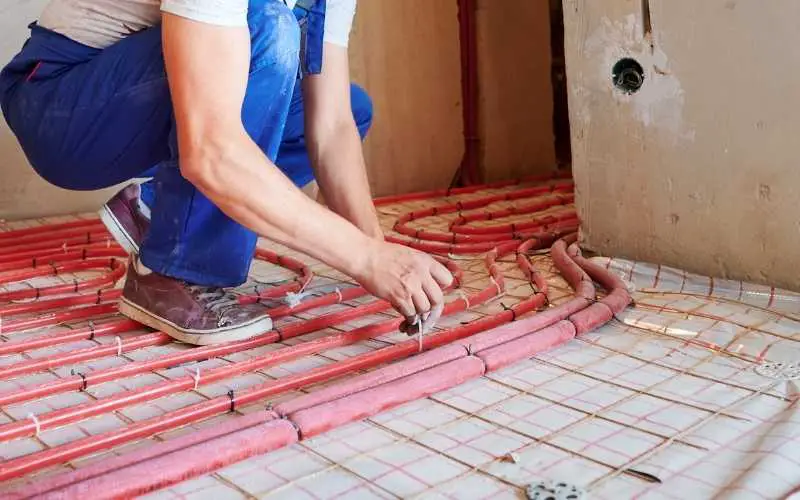The material’s thermal conductivity, or how quickly and efficiently heat generated transfers to the floor surface, is the fundamental difference between different flooring materials and their suitability for use with the system.
Flooring with strong conductivity is the most outstanding choice for underfloor heating since it heats up faster, produces more heat, and is more cost-effective.
Tile, stone, and polished screed, are the best floor for underfloor heating followed by wood floors which is closely followed by laminate, vinyl and carpet flooring.
However, this does not rule out less conductive materials for underfloor heating. Hard surfaces, such as stone or ceramic tiles, or engineered wood, provide the highest heat transfer since they are the most thermally conductive, but plenty of other possibilities exist.
We will outline and demonstrate what you need to know about the most suitable floorings for underfloor heating, and this will help you whether you’re renovating or choosing to floor for a new building.
Related: How to Install Radiant Heat Under Hardwood Floors
Best Floor for Underfloor Heating
Table of Contents
Any floor can benefit from underfloor heating. The material’s thermal conductivity is the sole difference between which floor finish to utilize with an underfloor system.
1. Tile, Stone & Polished Screed
Tile and stone are the best types of flooring to use with underfloor heating. Because tile and stone have high thermal conductivity, heat from an underfloor heating pipe or wire is quickly transferred to the floor surface.
The technique is highly efficient since tile and stone retain heat well. Tile and stone are suitable for use with underfloor heating in high heat loss locations such as conservatories because of their outstanding thermal characteristics.
They can be heated to temperatures of up to 29°C or higher, resulting in high heat output of up to 200W/m².
When looking for a highly responsive system, sticking to a maximum thickness of 20mm is recommended.
The thickness of the tile and stone has little impact on the heat output, but it does increase the heat-up time a little, so sticking to a maximum thickness of 20mm is recommended when looking for a highly responsive system.
Because tile and stone floors are highly conductive, they are ideal for underfloor heating systems.
Ceramic & Stone Tiles
Underneath the tile, there is stone and a polished finish. Screed, ceramic, and stone tiles are the best floor materials for underfloor heating.
It has a narrow profile and good heat transmission qualities. It’s also simple to clean.
2. Wood Flooring
Because different types of wood flooring have varying thermal qualities, their viability for use with an underfloor heating system varies.
The better the floors carry heat, the denser and thinner they are, and the more ideal they are for use with underfloor heating.
Because the moisture content of wood changes when the floor is heated, you should choose wood flooring that can respond to fluctuations in floor temperatures without affecting the floor’s appearance.
Kiln-dried wood is excellent for floor heating but verifies with the flooring maker to see if it’s suitable for use with underfloor heating.
Engineered Timber
This is the most incredible wood flooring for underfloor heating. It responds to altering moisture content and operates effectively with shifting floor temperatures.
Read: Best Underlay for Laminate Floor
3. Laminate Flooring
This synthetic floor has a wood-like appearance and is stain and scratch-resistant. It is simple to install and is a cost-effective option.
Although most laminates are suitable for use with underfloor heating, it is good to double-check with the flooring manufacturer before going ahead and installing the system.
4. Vinyl Flooring
Underfloor heating can be utilized securely with vinyl flooring. Vinyl quickly heats up and cools down.
Vinyl flooring has a top floor temperature constraint of around 27°C, limiting the heat output and making it unsuitable for high heat loss regions like older conservatories.
5. Carpet Flooring
Carpet can be used with underfloor heating as long as the carpet or underlay material does not function as an insulator and blocks the heat.
For the system to generate appropriate heat output, the total tog of all materials, including any under and overlays, must not exceed 2.5togs.
Underfloor heating is compatible with laminate and carpet floors. However, the total tog of all materials must not exceed 2.5togs for the system to produce enough heat output.
Flooring Material’s Impact on Heat Output
Because specific floor finishes have a peak temperature restriction, restricting the maximum heat output, the flooring you choose impacts the system’s maximum heat output.
The overall heated floor area and the air and floor temperatures determine the system’s heat output. Changing any of these three elements has an impact on heat output.
Changing the floor finish is usually the easiest because the room size and comfort air temperature are already reasonably determined.
It’s crucial to ensure that the floor’s heat output is larger than the room’s heat loss.
Read: How Do You Keep Your House Warm on Hardwood Floors?
Conclusion
Underfloor heating systems are a practical way to heat a property. With UFH systems, you can heat the entire house or particular rooms. UFHs are favored over radiators because they disperse heat more evenly.
Underfloor heating flooring comes in a variety of styles and heat ranges. It’s best to pick the best floor for underfloor heating for you based on the space or building.

